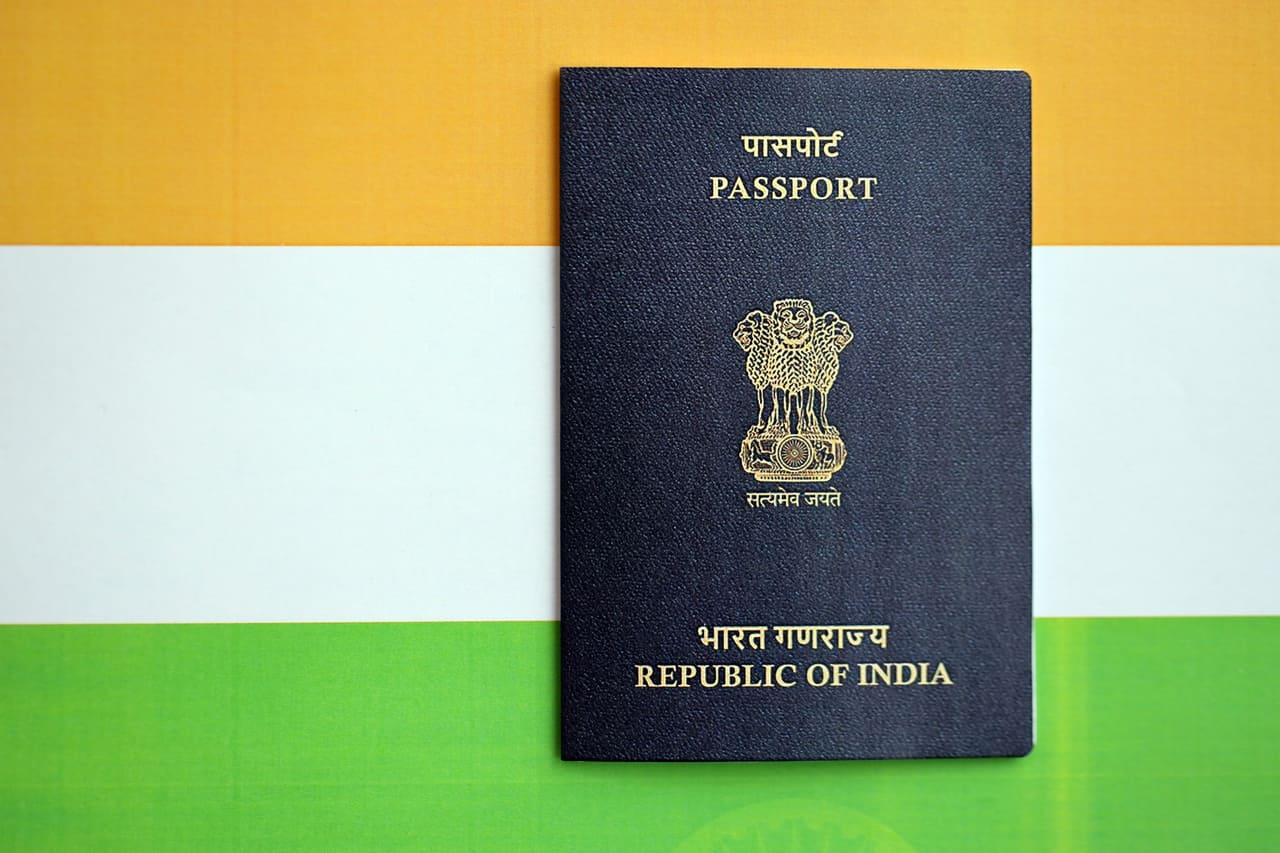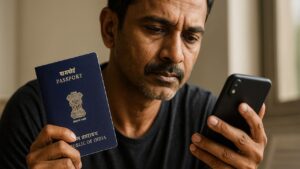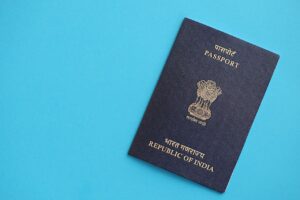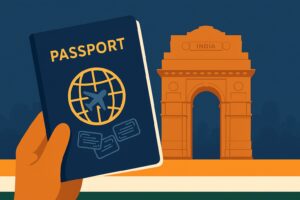
Every Indian passport has a unique code printed on its first page. This code is called the passport number, and it follows a fixed pattern. The official Indian Passport Number Format uses 8 characters alphanumeric code, one capital letter followed by seven digits. Example: K1234567.
This number is your official ID for international travel. It appears on the bio page of passport, and again in the machine-readable zone at the bottom. It is used for flight bookings, visa forms, immigration checks, and online verification.
Some people confuse it with the file number printed on the last page. But only the number on the front is the actual passport number. There is no passport book number in Indian passports.
In this post, you will learn the exact format of the Indian passport number, how the code works, what each part means, where it is located in your passport, and we will also explain common mistakes and how this number is used in real documents.
Need Expert Help on Your Passport Application?
Our passport agents handle forms, documents, and just one call away..
What is the Indian Passport Number
The Indian passport number is a unique travel ID printed on page one of your passport. It is issued by the Ministry of External Affairs and connects your identity with official records. This code is not just for the booklet. It works as your digital passport tag in the global system.
It links your passport to the photo, name, birthdate, nationality, and signature shown on the bio page. The same number also appears in the scanner zone at the bottom of the page for airport verification.
This number helps authorities track your passport for visa, immigration, and airline check-in. It also connects with the e-passport chip and the central passport record kept by the Passport Seva system.
Only one person can hold each Indian passport number. Once issued, this number becomes your identity code for all cross-border travel, digital forms, and international ID systems.
Indian Passport Number Format
The number on every Indian passport follows the same pattern. It has 8 characters in total. The first character is a capital letter. The next seven characters are numbers.
Example format: K1234567
This means:
- First part = 1 letter (like K or M)
- Second part = 7 numbers (from 0 to 9)
This format is used across all ordinary Indian passports. It is printed on the photo page, just above your name.
How to Read the Number Format
Each passport number starts with one letter. This letter is not random, it helps the passport office manage booklet series. After the letter, there are seven digits. The number is not picked randomly. It follows rules.
Important rules:
- The first digit after the letter should not be 0
- The last digit should not be 0
- All other digits in the middle can be anything from 0 to 9
These rules are built into the system to avoid confusion or typing mistakes.
Correct sample: A2345671 — starts with a letter, does not begin or end with zero.
Wrong sample: B0123450 — starts with zero after letter and ends in zero.
If a number breaks these rules, it is not a valid Indian passport number.
Writing the Number Correctly
The passport number must always be written without any space. But some people write it with a space for better reading. For example:
- Correct: M8251739
- Sometimes seen as: M82 51739 (not valid on forms)
For any online form or visa document, always type the full number with no space or dash. Use the exact 8 characters.
This number is used in your flight tickets, visa applications, and during immigration checks. It also appears at the bottom of the bio page in the scan lines that machines read.
Where to Find the Passport Number
The passport number is printed on the biographical information page of your Indian passport. This is the photo page, also called the bio page or identity page. Look at the top right corner. You will see a bold label that says Passport Number. followed by an 8-character code.
Besides being printed on the bio-data page, the passport number is also embedded in other parts of the passport for security:
It also appears in these three places:
- Machine-Readable Zone (MRZ): At the bottom of the photo page, there are two lines filled with letters, numbers, and < symbols. Your passport number is stored here for scanning at immigration. A special digit is added to detect typing mistakes or tampering.
- Perforated Pages: If you hold your passport to the light and flip through the visa pages, you will see the passport number punched through the top corner of every page. This is done by laser and cannot be copied. It proves the number matches the booklet.
- E-Passport Chip: In new Indian passports, a chip is hidden inside the cover. It stores your full name, date of birth, and passport number. Airport scanners read the chip and match it to the printed page for extra safety.
Why it matters:
- You need this number for all travel documents.
- Always copy it correctly. Do not confuse it with the file number on the last page.
- If the number is scratched, torn, or unreadable, you may be stopped at airport checks.
When and How to Use Indian Passport
An Indian passport is your key document for any trip outside India. It shows who you are, confirms your citizenship, and is used across airports, embassies, and visa offices. It holds your travel ID in a format that is accepted around the world.
When You Will Need to Show It
- While leaving India at airport gates
- During immigration check when entering a country
- When applying for a tourist, work or student visa
- At foreign embassy to verify identity
- For booking an international flight
- At airport e-gate to scan chip
- While checking into hotels in some countries
- At bank or for address proof if asked
How the Passport Is Verified
Officers read the photo page, scan the number, and match it to your face. The passport number appears on the photo page and again in the machine-readable zone. If you hold an e-passport, the chip inside stores the same data and your face or fingerprints. Machines use that chip to match your live photo, confirming your ID in seconds.
Even when not flying, your Indian passport can serve as a strong proof of identity. It is accepted by banks, hotels, KYC offices, and for official sign-ups. The passport bio page has your name, photo, and birth date, making it useful beyond travel.
How Passport Number Is Protected in Indian Passports
Indian passports use multiple security layers to keep the passport number safe from forgery or changes. These features protect both the booklet and the number printed inside.
Printed in Special Font
The passport number on the photo page is printed in bold, clear font. The letter and digits are easy to read, but hard to copy. Letters like O and digits like 0 are shaped differently to avoid confusion. Any change to this print style becomes instantly noticeable.
Perforated Across All Pages
If you flip through the passport, you will see the number punched through every page. These tiny holes form the same number again and again. It is called laser perforation. The number gets smaller as you move through the booklet. If anyone removes or adds a page, this pattern will break, making it clear something is wrong.
Verified by Machine Readable Zone
The same number is also printed again at the bottom of the identity page in a special scan line. This line is called the MRZ. It holds your number and a check digit. If the number does not match the check digit, the scan will fail. It means the number was typed wrong or someone tried to change it. This check keeps the passport safe at airports.
Stored Inside Barcode
On newer passports, you will find a barcode. It is printed on the back page or near the end. This barcode holds the same details as the main photo page, including the passport number. When the code is scanned, it matches with what is printed. If someone edits the printed number, it will not match the barcode scan.
Locked Inside the Passport Chip
All e-passports have a small chip inside the cover. This chip holds your personal data and passport number. When scanned at e-gates or immigration, the chip data must match the printed page. If there is any difference, the system catches it instantly. The chip is protected with a digital signature that cannot be faked or changed.
How to Verify an Indian Passport Number Online
The Indian passport number is a key identifier, and checking if it is valid is easy if you know where to look. You can do this both manually and online.
Check Online Using Passport Seva Portal
To verify a passport number online, visit the Passport Seva portal or use the mPassport Seva mobile app. Choose “Track Application Status” and enter the passport number and date of birth. If the number is valid, the system will display the real-time status of the passport. This confirms it was issued, is active, and belongs to the right person.
This check is helpful before filling in visa forms or travel details. You cannot access full passport records, but this is the safest public way to confirm that a number is genuine and currently in use.
Manual Checks on the Passport Itself
Look at the first page of the passport. The number is printed in bold near the top right. It must follow the correct Indian Passport Number Format: one capital letter followed by seven digits (like M1234567).
If the number starts with a zero or has two letters at the front, it is not valid. Indian passport numbers never begin with the digit 0, and never have symbols or extra letters.
To avoid mistakes:
- Do not confuse the letter O with the digit 0
- Do not add extra spaces or dashes
- Never use the file number (on the last page) as the passport number
Also, this number is perforated through all pages and printed again in the MRZ code at the bottom of the identity page. The MRZ includes a check digit that helps immigration machines verify if the printed number is real. If the number is changed or typed incorrectly, the scan will fail.
For e-passports, the number is stored in the microchip as well. When scanned at the airport, this chip confirms the number is correct and matches the printed bio page.
Common Doubts About the Indian Passport Number Format
Many people make small but critical mistakes when using their passport number. Below are clear answers and real-use insights that help prevent errors in bookings, form-filling, and document checks.
The Letter at the Start Does Not Represent Your Name or Region
The first character in every Indian passport number is just a serial letter. It does not reflect your name, city, or passport type. The type of passport (like ordinary or diplomatic) is printed separately as “Type P”, “Type S”, or “Type D” on the bio page. That letter is part of the internal series used to issue passport numbers. Once one series like M9999999 ends, the system moves to the next letter, such as N0000001.
Format Has Not Changed to Two Letters
There is no update to the format. Indian passport numbers still use one capital letter followed by seven digits. Some users get confused because other countries like Canada or Germany use two-letter prefixes. India follows only an 8-character code. Any passport number that starts with two letters or contains nine characters is invalid for Indian passports.
Passport Number and File Number Are Not the Same
Your passport number is printed on the front (bio page) and has exactly 8 characters. The file number is a longer alphanumeric code printed on the last page. It helps track your application and often includes a city code (like DEL or BNG), a serial number, and a year. Never enter the file number into visa or travel forms asking for passport number.
Do Not Mistake Letter O for Zero
Indian passport numbers never begin with the digit zero. If the first character looks like a zero, it is the letter O. Fonts in passports make this easy to read, but it can still be confusing. Always remember that only the first character is a letter, and all characters after that are digits. Any zero found in the middle or end of the number is a numeric 0, not a letter.
Always Copy Your Passport Number Exactly
You must use the passport number without any spelling mistakes or spacing when applying for a visa, booking flights, or filling out forms. Airlines and immigration systems link your data to that exact number. One wrong digit or missed letter could mean your visa will not match your passport, and airport checks could fail. The best way to avoid this is to copy it directly from the passport photo page every time.
FAQ’s
How many characters are in an Indian passport number?
An Indian passport number is always 8 characters long. It has one letter of the English alphabet followed by seven digits 1 . For example, M<small>1234567</small> is a valid passport number (M plus seven numbers).
What does a typical Indian passport number look like?
It looks like a letter followed by six other numbers and then a final number. For example, A1234567 is the format – here “A” is the letter and “1234567” is the numeric part 1 . Every Indian passport will have a similar pattern (the letter can be different for different passports, and of course the digits will vary for each person).
Can an Indian passport number ever have two letters or nine digits?
No. Indian passport numbers do not use two-letter codes or a nine-digit sequence. They strictly use one letter + seven digits. If you see something with two letters and six digits, or any 9-character code claiming to be an Indian passport number, that is not a valid format 12 . It might be referring to a different code or it’s simply incorrect.
Is the passport number the same as the passport file number or reference number?
No, they are different. Your passport number is the 8-character code printed on the main page of the passport. The passport file number (sometimes called a reference number) is a longer code associated with your application and is often printed on the last page of the passport.
For example, the file number might look like “BNGXXXXXXXX2023” which includes letters and more digits. This is used for tracking your application and is not used as an identifier for travel. Always use the 8-character passport number for bookings and official forms, not the longer file number.
What should I do if I accidentally wrote my passport number wrong on a form (e.g., one digit off)?
It’s important to correct it as soon as possible. A mismatch between the passport number on your documents and the actual passport can lead to issues. If it’s a visa application, contact the visa office or update the form if it’s still in process.
If it’s a flight booking, reach out to the airline to have them correct the passport info in your booking. Since passport numbers are unique, even a one-character error means the information refers to a completely different (and likely non-existent) passport.
Q: Are Indian passport numbers reused after a passport expires?
Generally, no – when you renew your passport, you will get a new passport number (typically with a different letter or number sequence than your old one). Old passport numbers are not immediately reused for new issues to other people, so your previous number stays associated with your old passport record.
Why is it important to keep my passport number secure?
Your passport number is a personal identifier. While on its own it’s not as sensitive as, say, a password or bank detail, it’s still part of your personal data. Do not share it casually on public forums. Someone could misuse your passport number for identity theft or fraudulent activities, especially if they obtain other details of your passport.
Always provide your passport number only on official forms or to trusted parties (like airlines, government visa websites, employers for verification checks, etc.).
Still Confused About the Process? Talk to a Passport Agent Today
Conclusion
Your Indian passport number is your global ID. It is printed clearly on the first page, follows a fixed format, and links every official record of your travel. Always check the number carefully before using it on any form, flight booking, or visa.
Keep your passport safe, avoid writing errors, and never confuse the file number or use extra spacing. A small mistake can lead to big delays at check-in or border control.
For smooth travel and valid identification, treat your passport number as your most trusted code.
 Passport Guide
Passport Guide

